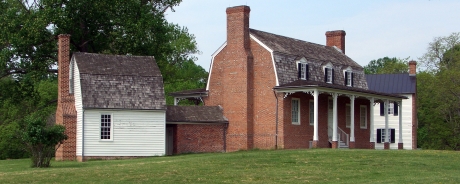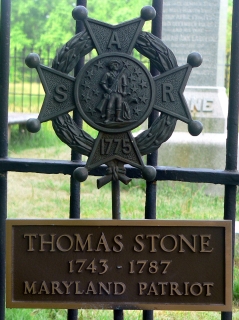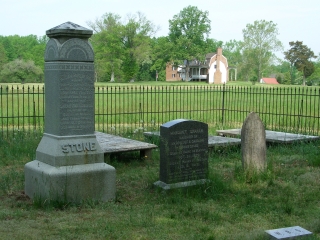NPS Website; Local Website
 WHAT IS IT?
WHAT IS IT?1000+ acre plantation home of Thomas Stone, who, the Park admits, was the least exciting of Maryland’s Declaration of Independence signers.
BEAUTY (3/10)
Haberdeventure, the centerpiece of the Stone farm, consists of a reconstructed main red brick Colonial home with East and West wings that arc into a semi-circle. The house itself in nondescript; very few original artifacts remain inside. A small family cemetery is tucked away in a corner of the Site. Some original barns and outbuildings dot the landscape.
HISTORICAL INTEREST (3/10)
Not only is Haberdaventure not pretty, it is not even the original house. The Park Service acquired the house and the land after a fire in 1977 completely gutted the home. It is not as if this Site provides a window into the lifestyle of some of the signers of the Declaration; even the parlor paneling was sold off by the Stone family to the Baltimore Museum of Art.
Why did NPS choose to purchase and rebuild an unattractive home of an unexciting person who just happened to be in the right place at the right time? Well, the 8-minute film tells us that it is to show that not every signer of the Declaration of Independence was 100% sold on the idea of America as an independent nation; that moderation and thoughtfulness are often overlooked. Thomas Stone is portrayed as an ordinary man in extraordinary times overwhelmed by the revolutionary ideas that might possibly have disrupted his quiet country home.
CROWDS (5/10)
We were the only visitors to the Site. Perhaps if there were another visitor, we might have learned of a reason to be interested.
EASE OF USE/ACCESS (3/5)
A Park Ranger indicated that Thomas Stone NHS became a Park Site because of its proximity to Washington DC. Well, the Site is close to DC only in the sense that it is no closer to anything else. The DC Beltway (I-495, 95) Exit 7 is a circuitous two-lane, stop-and-go 30 miles to the north via Maryland Route 5, US Route 310 and Maryland Route 6.
 Rand McNally designates the places along the way, Waldorf, White Plains and La Plata, with the small print of baby towns. Perhaps that will change after the 2010 census. These towns are booming with families fleeing Washington DC. Every imaginable chain restaurant litters Route 310. The area has grown faster than its roads. As a result, your journey to Thomas Stone NHS will take much longer that the reasonable mileage distance would indicate.
Rand McNally designates the places along the way, Waldorf, White Plains and La Plata, with the small print of baby towns. Perhaps that will change after the 2010 census. These towns are booming with families fleeing Washington DC. Every imaginable chain restaurant litters Route 310. The area has grown faster than its roads. As a result, your journey to Thomas Stone NHS will take much longer that the reasonable mileage distance would indicate.CONCESSIONS/BOOKSTORE (2/5)
Children’s books aside, the Site’s selection struggles to break the double-digit barrier but it is not as if there are volumes dedicated to the Park’s honoree. Indeed, only one book, Thomas Stone – Elusive Maryland Signer, has ever been written about the man and it’s for sale here. The bookstore did not have to work hard to find the book; its authors live adjacent to the Park. Seriously.
COSTS (4/5)
The Site is free.
RANGER/GUIDE TO TOURIST RATIO (3/5)
Two Rangers; two of us. Why the low rating? It seems that we were invisible. The Rangers were more intent on unfolding their newspapers and settling down to a quiet day of no visitors than helping us gain any insight to Mr. Stone and his predicament. We felt like we totally disrupted their morning routine. Sorry.
TOURS/CLASSES (3/10)
Visitors enter the home via the West Wing, which houses a large fireplace (not the original), informational panels and a small TV for the introductory film. The film and new educational panels ably explain who Thomas Stone was and what his political beliefs were: a wealthy lawyer turned plantation owner and moderate to the point of passivity, respectively. The video admits that Stone contributed little to the Continental Congress, tended towards silence and was very cautious. (At this point in the video, we both laughed out loud).
The Site’s primary lesson is that not every Founding Father was passionate, pro-revolution, bursting with political philosophies and compelling. Is this a helpful lesson? We say no, our History PhD. candidate friend says yes. Nonetheless, we both agreed that that lesson is not worth the vexing drive to one of Maryland’s sprawling peninsulas let alone the millions of dollars the NPS spent restoring Stone’s uninspiring mansion.
FUN (2/10)
We were more than a little surly when we realized our morning navigating parkways and rush hour traffic dropped us here. At least we found an Einstein Bagels and some cheaper gas (compared to DC) along the way.
 WOULD WE RECOMMEND? (1/10)
WOULD WE RECOMMEND? (1/10)Thomas Stone was so dispassionate about our young nation that in 1787, after being chosen to represent Maryland at the Constitutional Convention, he declined in favor of tending to his sick wife. Stone had an opportunity to construct the future of our country, an opportunity to participate in one of the defining moments of the world’s political history. Instead, he chose to stay home.
You should do the same. Do not come here.
Stone chose to remove himself from history and the birth of the United States. There is no reason to honor his memory. His inclusion in the federally run and taxpayer supported National Park System is far more egregious than the incorporation of Sites honoring defiant scoundrels like George Rogers Clark and Charles Pinckney. At least they did something. Stone’s past is even worse. He never cared, he never talked, he was silently pragmatic, revolutionary only because it was the only choice and pro-actively aloof regarding America’s future.
TOTAL 29/80
www.usa-c2c.com
© 2004-06